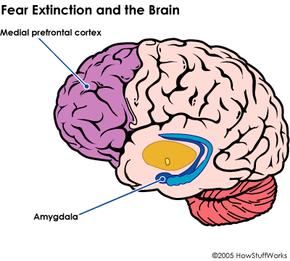Overcoming Fear
Studies have shown that rats with damaged amygdalas will walk right up to cats [ref]. Most of us aren't too keen on the prospect of going at our amygdala with an ice pick, though. So scientists are exploring other ways to overcome fear.
Fear extinction
Whereas Little Albert learned to fear white rats in the 1920s, rats learned to fear a simple noise more than 80 years later. Scientist Mark Barad of UCLA performed an experiment in which he and his team combined a noise with an electric shock. They would play the tone and then immediately apply a shock to the metal floor of the rats' cage. It was classical conditioning, and it didn't take long for the rats to brace themselves for the shock as soon as they heard the sound. At that point, their amygdalas paired the sound with the shock, and the sound created a fear response. The researchers then began the process of fear-extinction training, in which they made the sound but did not apply the shock. After hearing the sound very often without the shock, the rats stopped fearing the noise.
Advertisement
Fear extinction involves creating a conditioned response that counters the conditioned fear response. While studies situate the amygdala as the location of fear memories formed by conditioning, scientists theorize that fear-extinction memories form in the amygdala but then are transferred to the medial prefrontal cortex (mPFC) for storage. The new memory created by fear extinction resides in the mPFC and attempts to override the fear memory triggered in the amygdala.
Most behavioral therapies for fear extinction focus on exposure. For instance, therapy for a person with a fear of snakes might involve visiting a snake farm repeatedly and taking small steps toward touching one. First, the person might get within 10 feet of the snake and see that nothing terrible happens. Then he might get within 5 feet of the snake. When nothing terrible happens within 5 feet of the snake, he might get close enough to touch it. This process continues until new, fear-extinction memories are formed -- memories that say "snakes are not going to harm you" and serve to contradict the fear of snakes that lives in the amygdala. The fear still exists, but the idea is to override it with the new memory.
